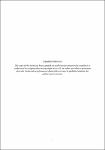Assessing the efficacy of a novel galactooligosaccharide to promote fish health and robustness
| dc.contributor.supervisor | Merrifield, Daniel | |
| dc.contributor.author | Sykes, Lucy May | |
| dc.contributor.other | School of Biological and Marine Sciences | en_US |
| dc.date.accessioned | 2023-03-21T16:41:59Z | |
| dc.date.issued | 2023 | |
| dc.identifier | 10351809 | en_US |
| dc.identifier.uri | https://pearl.plymouth.ac.uk/handle/10026.1/20613 | |
| dc.description.abstract |
Aquaculture has been steadily increasing global production; however, there remains a progressively greater demand for sustainable sources of protein, whilst the prevalence of disease represents a major constraint to industry growth. Feed additives are gaining traction as useful tools to help combat disease and promote health, and previous research has documented benefits to the mucosal surfaces and microbial communities within a range of teleost species. Three experimental in vivo feeding trials were undertaken using a range of in-depth analyses, such as growth performance, haematology, immunology, intestinal histology, intestinal gene expression and intestinal bacterial 16S rRNA sequence libraries. Studies were conducted on three important aquaculture species: rainbow trout (Oncorhynchus mykiss), Atlantic salmon (Salmo salar) and Nile tilapia (Oreochromis niloticus). All three experiments revealed that dietary B-GOS® applications modulated the intestinal bacterial communities and intestinal gene expression. Some of these modulations may have potential benefits at the localised level for the hosts. However, no significant improvements of growth performance metrics were observed at the whole organism level, where FCR, SGR, survival, weight gain, condition factor and body composition remained unaffected by treatment. Despite the lack of statistical significance, numerical improvements indicated that GOS at the inclusion rate of 4g kg¯¹ was the optimal concentration. Results from the experimental in vivo trials conducted during this research have provided evidence that a novel GOS tested in three commercially important teleost species had scope to improve localised intestinal health but offered little benefit to growth performance of fish reared with highly nutritious diets and excellent rearing conditions. Further research should prioritise the 4g kg¯¹ B-GOS® inclusion level for further investigation in these fish species whilst under pathogenic or environmental challenge, as this concentration presented the most potential to improve fish health and growth performance. | en_US |
| dc.language.iso | en | |
| dc.publisher | University of Plymouth | |
| dc.rights | Attribution-NonCommercial-NoDerivs 3.0 United States | * |
| dc.rights.uri | http://creativecommons.org/licenses/by-nc-nd/3.0/us/ | * |
| dc.subject | aquaculture | en_US |
| dc.subject | feed additives | en_US |
| dc.subject | prebiotics | en_US |
| dc.subject | salmon | en_US |
| dc.subject | trout | en_US |
| dc.subject | tilapia | en_US |
| dc.subject | GOS | en_US |
| dc.subject.classification | PhD | en_US |
| dc.title | Assessing the efficacy of a novel galactooligosaccharide to promote fish health and robustness | en_US |
| dc.type | Thesis | |
| plymouth.version | publishable | en_US |
| dc.identifier.doi | http://dx.doi.org/10.24382/2666 | |
| dc.rights.embargodate | 2024-03-21T16:41:59Z | |
| dc.rights.embargoperiod | 12 months | en_US |
| dc.type.qualification | Doctorate | en_US |
| rioxxterms.version | NA |
Files in this item
This item appears in the following Collection(s)
-
01 Research Theses Main Collection
Research Theses Main



